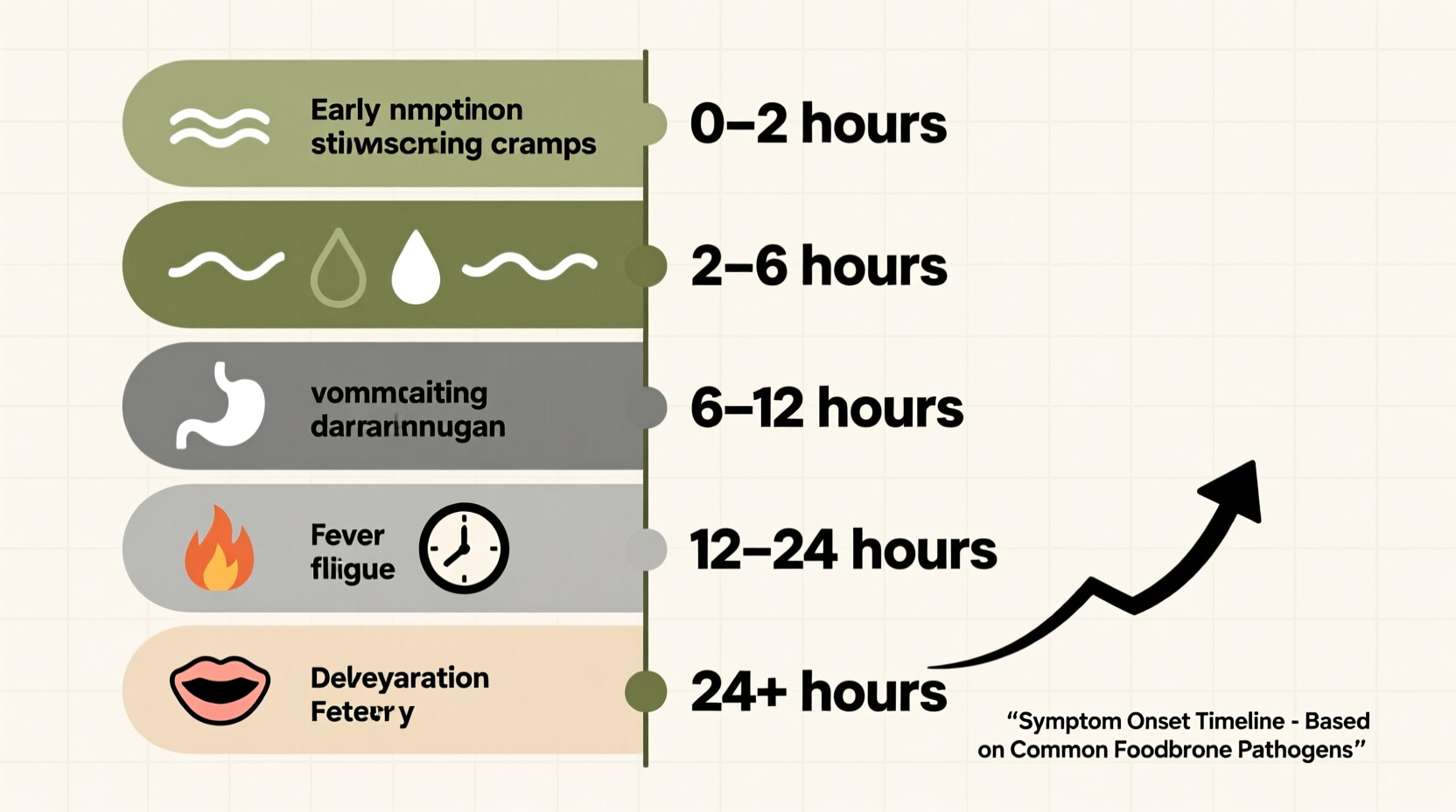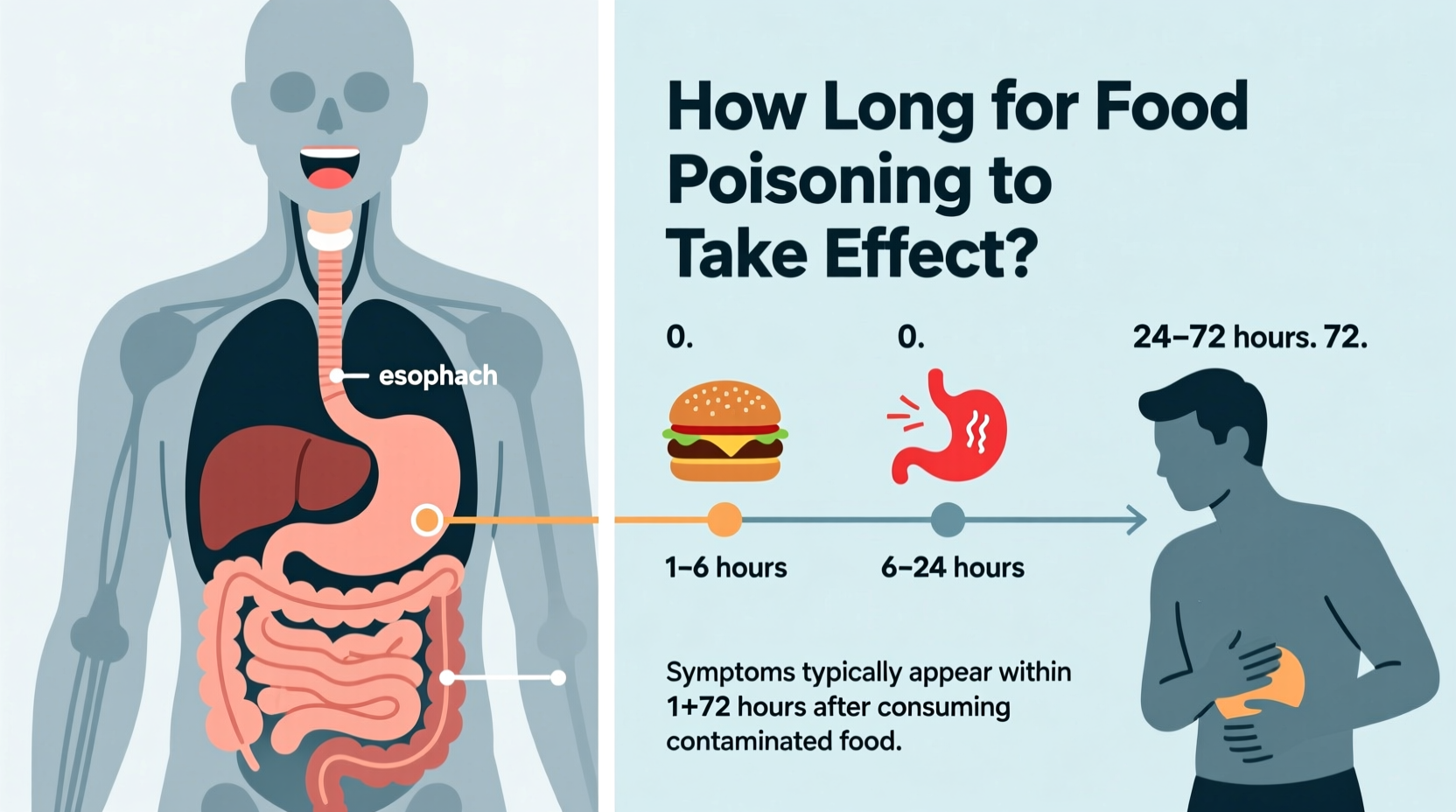Understanding Food Poisoning Onset: Your Essential Timeline Guide
When you've potentially consumed contaminated food, knowing how long for food poisoning to take effect becomes critically important. This knowledge helps you determine whether your symptoms are food-related and when to seek medical attention. Unlike what many believe, food poisoning doesn't always strike immediately after eating—timing varies significantly based on multiple factors.
Why Food Poisoning Onset Times Vary Significantly
The time it takes for food poisoning symptoms to manifest isn't random—it follows specific biological patterns determined by the contaminant. Understanding how soon after eating contaminated food symptoms appear requires examining three key elements:
- Pathogen type—bacteria, viruses, parasites, or toxins each have distinct incubation periods
- Exposure amount—larger quantities of pathogens typically accelerate symptom onset
- Individual factors—age, immune status, and stomach acidity affect vulnerability
Food Poisoning Timeline: From Exposure to Symptoms
Below is a visual representation of the typical progression after consuming contaminated food:
| Time After Consumption | Biological Process | What You Might Experience |
|---|---|---|
| 0-2 hours | Toxin absorption begins | None typically (except with pre-formed toxins) |
| 2-6 hours | Toxins reach critical levels | Nausea, vomiting (with staphylococcal or Bacillus cereus toxins) |
| 6-24 hours | Bacterial colonization begins | Early symptoms with Salmonella, E. coli |
| 24-72 hours | Pathogen replication peaks | Full symptom development for most bacterial infections |
| 3-28 days | Slow-replicating pathogens establish | Symptoms from Hepatitis A, Listeria, or parasites |
Pathogen-Specific Onset Times: What Research Shows
According to the Centers for Disease Control and Prevention (CDC), different pathogens have characteristic incubation periods. This food poisoning incubation period chart provides specific timelines based on the latest medical research:
| Pathogen | Typical Onset Time | Common Sources | Key Symptoms |
|---|---|---|---|
| Staphylococcus aureus | 30 min - 8 hours | Deli meats, salads, pastries | Sudden vomiting, nausea |
| Bacillus cereus (vomiting type) | 1-6 hours | Fried rice, leftovers | Nausea, vomiting |
| Salmonella | 6-48 hours | Raw eggs, poultry | Diarrhea, fever, cramps |
| E. coli (O157:H7) | 1-10 days | Undercooked beef, leafy greens | Severe cramps, bloody diarrhea |
| Norovirus | 12-48 hours | Contaminated surfaces, shellfish | Vomiting, diarrhea, stomach cramps |
| Listeria | 1-4 weeks | Soft cheeses, deli meats | Fever, muscle aches, confusion |
| Hepatitis A | 15-50 days | Contaminated water, shellfish | Fatigue, jaundice, abdominal pain |
Data source: Centers for Disease Control and Prevention Foodborne Illness Causes and Outbreaks
When Food Poisoning Symptoms Appear Faster Than Expected
Certain conditions can accelerate how quickly food poisoning sets in after eating. The FDA Food Code identifies these critical factors that shorten the typical incubation period:
- Pre-formed toxins—when bacteria have already produced toxins in food before consumption (like in improperly stored rice or dairy products)
- High pathogen concentration—food left in the temperature danger zone (40°F-140°F) for extended periods allows rapid bacterial multiplication
- Compromised stomach acidity—people taking antacids or proton pump inhibitors may experience faster symptom onset
- Extreme temperatures—very hot or cold foods can accelerate toxin absorption

Situations Where Onset Time Might Mislead You
Understanding how long it takes to get sick from food poisoning becomes complicated in these scenarios:
- Mixed pathogen exposure—consuming multiple contaminated items can create confusing symptom patterns
- Delayed immune response—some pathogens like Listeria may take weeks to manifest symptoms
- Asymptomatic carriers—you might be exposed without immediate symptoms but become contagious to others
- Medication interference—anti-nausea medications can mask early symptoms, creating false reassurance
According to a 2023 study published in the Journal of Food Protection, 68% of people incorrectly attribute their food poisoning to the last meal they ate, when symptoms often reflect contamination from 12-72 hours earlier. This misattribution delays proper treatment and complicates outbreak investigations.
What to Do While Monitoring for Symptoms
If you suspect you've consumed contaminated food, follow these evidence-based steps while watching for how long before food poisoning symptoms start:
- Document everything—write down what you ate, when, and with whom (helpful for medical diagnosis)
- Stay hydrated—sip water or oral rehydration solutions even before symptoms appear
- Avoid anti-diarrheal medications—they can prolong infection by preventing pathogen elimination
- Monitor high-risk individuals—children, elderly, and immunocompromised people need closer observation
- Contact healthcare provider if you've consumed high-risk foods like raw shellfish or unpasteurized dairy
When to Seek Immediate Medical Attention
Don't wait for symptoms to worsen. Contact a healthcare provider immediately if you experience any of these warning signs, regardless of how long it takes for food poisoning to kick in:
- Symptoms appearing within 2 hours of eating (suggesting possible chemical or toxin exposure)
- Blood in vomit or stool
- Signs of dehydration (dry mouth, little urination, dizziness)
- Fever above 101.5°F (38.6°C)
- Neurological symptoms like blurred vision or muscle weakness
The American College of Gastroenterology emphasizes that timely intervention can prevent complications, especially for vulnerable populations. When in doubt, consult a healthcare professional rather than waiting to see if symptoms develop.
Preventing Food Poisoning: Beyond Just Timing
While understanding how long after eating contaminated food you get sick is important, prevention remains your best defense. Implement these evidence-based food safety practices:
- Follow the 2-hour rule—refrigerate perishables within 2 hours (1 hour if temperature exceeds 90°F/32°C)
- Cook foods to proper internal temperatures (165°F/74°C for poultry, 145°F/63°C for fish)
- Prevent cross-contamination by using separate cutting boards for raw meats and produce
- Wash hands thoroughly for 20 seconds before and after handling food
- When traveling, follow local food safety advisories and avoid high-risk items
Frequently Asked Questions
Can food poisoning symptoms appear within 30 minutes?
Yes, certain foodborne toxins can cause symptoms within 30 minutes to 6 hours. Staphylococcus aureus and Bacillus cereus (vomiting type) produce pre-formed toxins that trigger rapid onset nausea and vomiting. These typically occur when foods like rice, dairy products, or salads have been left at room temperature for several hours, allowing bacteria to multiply and produce toxins before consumption.
Why do some people get food poisoning faster than others?
Individual factors significantly affect how quickly food poisoning symptoms develop. People with lower stomach acidity (due to medications or medical conditions), compromised immune systems, or higher pathogen exposure levels may experience faster symptom onset. Age also plays a role—children and elderly individuals often show symptoms sooner due to less robust digestive and immune systems.
Can food poisoning take days to show symptoms?
Absolutely. Some pathogens have extended incubation periods. Listeria can take 1-4 weeks to manifest symptoms, Hepatitis A may take 15-50 days, and certain parasitic infections like Cyclospora can take 7 days or more. This delayed onset often leads people to incorrectly identify the contaminated food source, as they mistakenly associate symptoms with their most recent meal rather than food consumed days earlier.
How long after eating bad sushi do symptoms appear?
Symptoms from contaminated sushi typically appear within 4-10 days for bacterial infections like Salmonella, but can range from immediate (with pre-formed toxins) to several weeks (with parasites like Anisakis). Norovirus from contaminated shellfish usually shows symptoms in 12-48 hours. The FDA reports that raw fish consumption accounts for approximately 18% of foodborne illness outbreaks linked to seafood, with symptom onset varying based on the specific contaminant.
Does cooking contaminated food eliminate the risk of food poisoning?
Not always. While proper cooking kills most bacteria, some pathogens produce heat-stable toxins that remain dangerous even after cooking. For example, Staphylococcus aureus toxins aren't destroyed by standard cooking temperatures. Additionally, if food has been contaminated with viruses like norovirus, cooking may not eliminate all risk. The CDC emphasizes that prevention through proper food handling, storage, and hygiene remains more effective than relying solely on cooking to eliminate foodborne illness risks.











 浙公网安备
33010002000092号
浙公网安备
33010002000092号 浙B2-20120091-4
浙B2-20120091-4